#Carboniferous plant fossil
Explore tagged Tumblr posts
Photo

Lepidodendron Fossil Stem – Carboniferous Plant Fossil – Coal Measures – Radstock, Somerset, UK
Genuine Lepidodendron Stem Fossil – Carboniferous Period – Radstock, Somerset, UK
This is a fine example of a Lepidodendron stem fossil – a relic of an ancient lycopsid tree that once towered over Carboniferous swamplands. This piece was recovered from the classic Coal Measures of Radstock, Somerset, a region famous for its rich palaeobotanical heritage.
Fossil and Geological Information:
Species: Lepidodendron (exact species undetermined)
Family: Lepidodendraceae
Order: Lepidodendrales
Class: Lycopodiopsida
Geological Stage: Pennsylvanian Subsystem, Late Carboniferous (~310 million years ago)
Formation: British Upper Coal Measures
Location: Radstock, Somerset, UK
Depositional Environment: Equatorial deltaic swamps, ideal for forming peat-rich layers later turned into coal
Notable Morphological Features:
Distinctive diamond-shaped leaf scars arranged in spiral rows, left by fallen microphylls
Ribbed or bark-like surface textures indicative of its large, arborescent form
Rare preservation showing clear stem features of a major component of Carboniferous forests
Palaeontological Context:
Lepidodendron was a dominant genus in the Carboniferous forests and contributed significantly to coal formation. Known as a “scale tree,” it could grow over 30 meters high. This stem fossil captures the unique and unmistakable leaf scar patterns that define the genus.
Specimen Details:
Discovered by: UKGE team members Alister and Alison
Discovery Date: 06 March 2025
Prepared by: Alison
Scale Information: Scale cube shown = 1cm – see photo for precise dimensions
Photographic Guarantee: The item pictured is the exact specimen you will receive
Authenticity: Includes a signed Certificate of Authenticity. We guarantee all our fossils are 100% genuine and responsibly collected.
Why This Fossil is Important:
Lepidodendron was a cornerstone of prehistoric forest ecosystems during the Carboniferous period, influencing the development of today’s ecosystems and even contributing to modern fossil fuel deposits. This well-preserved specimen is not only ideal for collectors but also serves as an excellent educational piece demonstrating the structure and texture of ancient lycopsid trees.
An iconic and timeless addition to any fossil collection.
#Lepidodendron fossil#Carboniferous plant fossil#fossil stem impression#fossil lycopsid tree#Lepidodendron stem#Coal Measures fossil#Carboniferous flora#Radstock fossil plant#authentic fossil stem#lycopodiophyta#British fossil plant#prehistoric swamp forest#fossil bark impression
0 notes
Text

"Pennsylvanian book about Fossil Plants" is a comprehensive picture guide detailing fossil plants and marine organisms found alongside coal measures in Southwestern Virginia. Sorted by groups and coal seam horizon, it includes brief descriptions of each plant type. With 57 plates and over 280 illustrations, most in color, it caters to both amateur rock hounds and advanced collectors alike. For those eager to explore further, visit the book's website: https://www.tfmcloughlin.com/book/ for more information.
#Thomas F. McLoughlin#A Guide to Penssylvanian Age#Plant Fossils#Carboniferous#Southwest Virginia#ReadersMagnet#fossils#ancient plants#paleontology#paleobotany#fossil plants#nature
4 notes
·
View notes
Text
Here's a selection of other fossils I've found over my last few trips to this site:


Asterophyllites, a form genus for the foliage of Calamites.


Fronds of Neuropteris.

A charcuterie board of Macroneuropteris and Pecopteris.

Macroneuropteris frond (I normally find them as individual leaves!)


A Macroneuropteris leaf that has oxidized in a way that turned it iridescent like an oil slick.


My pride and joy... This huge Pecopteris frond!
There are many more, I might post some of them at some point.
I returned to a Pennsylvanian (late Carboniferous) site I had visited a few times and I finally found some Sphenophyllum!


#paleobiology#paleontology#paleoblr#paleobotany#geoscience#geology#plants#evolution#carboniferous#pennsylvanian#horsetail#Sphenophyllum#Calamites#Asterophyllites#medullosan#seed fern#Neuropteris#Macroneuropteris#fern#tree fern#Pecopteris#fossils
44 notes
·
View notes
Text

A new Carboniferous edaphosaurid and the origin of herbivory in mammal forerunners
Abstract
Herbivory evolved independently in several tetrapod lineages during the Late Carboniferous and became more widespread throughout the Permian Period, eventually leading to the basic structure of modern terrestrial ecosystems. Here we report a new taxon of edaphosaurid synapsid based on two fossils recovered from the Moscovian-age cannel coal of Linton, Ohio, which we interpret as an omnivore–low-fibre herbivore. Melanedaphodon hovaneci gen. et sp. nov. provides the earliest record of an edaphosaurid to date and is one of the oldest known synapsids. Using high-resolution X-ray micro-computed tomography, we provide a comprehensive description of the new taxon that reveals similarities between Late Carboniferous and early Permian (Cisuralian) members of Edaphosauridae. The presence of large bulbous, cusped, marginal teeth alongside a moderately-developed palatal battery, distinguishes Melanedaphodon from all other known species of Edaphosauridae and suggests adaptations for processing tough plant material already appeared among the earliest synapsids. Furthermore, we propose that durophagy may have provided an early pathway to exploit plant resources in terrestrial ecosystems.
Read the paper:
A new Carboniferous edaphosaurid and the origin of herbivory in mammal forerunners | Scientific Reports (nature.com)
209 notes
·
View notes
Note
If the dinosaurs never went extinct then would there still be fossil fuels?
- dinosaurs didn’t go extinct, birds are dinosaurs
- fossil fuels come from fossil plants and marine invertebrates. Dinosaurs are not the source of fossil fuels.
- fossilisation happens regardless of whether or not a species goes extinct, there are fossils of living species. It’s just something that happens to dead organisms in the right conditions
- fossil fuels amass when there’s just giant quantities of dead organic material, like in the Carboniferous Coal Forests. So yeah, they were always going to exist in a world where life does so well.
445 notes
·
View notes
Text
Fish of the Day
Happy Thursday, everyone! Today's fish of the day is the Australian lungfish!

The Australian lungfish, or barramunda, known by scientific name Neoceratodus forsteri is one of the 6 surviving lungfishes of the modern world. The other 5 lungfishes are scattered to other sections of the world, one in South America, and the other 4 all living in Africa. As the name implies, this lungfish is endemic to Australia living in South Eastern Queensland, or for those who don't know the general areas of Australia, the upper right corner of the country. Living exclusively in slow moving streams, still waters, and various waterside banks living entirely in freshwater systems. This fish is primarily nocturnal, and almost entirely carnivorous. Its diet consists of: frogs, larvae, bugs, plant material, earthworms, fishes, small invertebrates, and anything else it can catch. They are primarily bottom dwellers, and prey is caught directly in the mouth and then crushed multiple times, being positioned correctly by a bone called a hydroid apparatus. Australian lungfish have the most primitive of surviving lungfish feeding behaviors.

Australian lungfish are best known for their ability to survive dry seasons. However, unlike African lungfish, which can survive fully in droughts by submerging themselves into This is done by submerging the body in the mud, and rising to the surface to swallow oxygen into a single dorsal lung. This lung is only supplementary, and the fish prefer to breathe through their 5 gills. Of the six lungfish, the Australian lungfish is the only one to not have two lungs, but rather a fold down the center of the single lung acting as a wall, which blood capillaries run through, allowing gas exchange. Unlike it's African counterparts, the Australian lungfish can not survive total water depletion, (other lungfish survive this by creating a layer of mucus around itself and living there for several years until water returns). Australian lungfish can survive several days out of the water, but can not do so unless it is in a moist environment, usually mud.

Fossil records of lungfish tell us that some of their first fossils can be found from 410 Million years ago, being the closest living relative to the tetrapod. The last shared ancestor between the lungfish and tetrapod was 420 Million year ago. Originally, these animals started as marine creatures, but sometime in the carboniferous the species became freshwater exclusive, around the same time that the last common ancestor to all remaining lungfish lived. Australian lungfish in particular appear to have split off about 380 million years ago, and have remained virtually unchanged from their ancestors for over 100 million years, giving them the title of living fossils!

Not only have they remained incredibly similar over the years, they have a long lifespan for individuals as well. A captive Australian lungfish named granddad was shown to live to 108 years (+- 6), with the expected lifespan of wild lungfish surviving at least 20-25 years after they reach sexual maturity. In Australian lungfish, similar to other lungfish species in the world, sexual maturity is reached in males after 17 years, and 22 years in females. Australian lungfish have elaborate courting rituals consisting of three distinct phases. The first phase is searching, where the lungfish will breathe loudly, making mating calls with its single lung. The second is called "follow the leader" where males will attempt to entice a female by nudging and rubbing snouts with her, often at the same time as competitors. The last stage is where two lungfish will descend to lay and fertilize eggs, females producing 2 eggs per spawning season. After breeding, the eggs are left to sink in the vegetation, as Australian lungfish do not nest or care for their young. This is unlike all other lungfish species.

Have a wonderful Thursday, everyone!
#fish#fish of the day#fishblr#freshwater fish#freshwater#australian lungfish#Barramunda#queensland lungfish#lungfish#australia#living fossils
128 notes
·
View notes
Text

(Image, as well as much of my information, from Carboniferous Giants and Mass Extinction by George R. McGhee Jr.)
Take a look at this tree. On a scale of 1 to 10, how weird do you think it is?
You quite possibly just gave it a 3 or a 4 or something. Sure, it's a little odd, but does look vaguely normal, right? A friend of mine guessed it was some sort of baobab when I showed him the image.
This is, in fact Lepidodendron, an ancient tree from the Carboniferous, and by modern tree standards it is absolutely bizarre. Its closest surviving relatives, quillworts and clubmosses, only grow to a height of a few centimetres, yet Lepidodendron were giants that shot up to 50 metres tall... Briefly, before dispersing their spores and completely dying off.
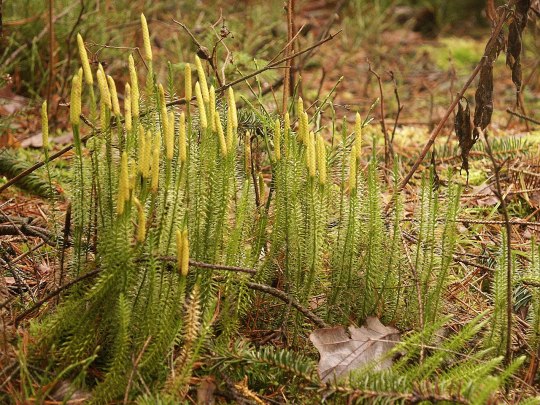
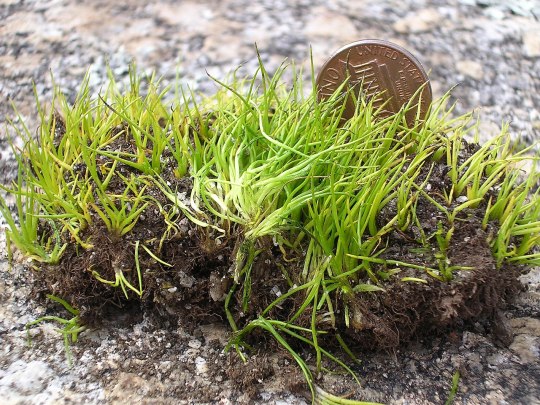
(Lycopodium and Spinulum, modern relatives of Lepidodendron, photos by Bernd Haynold and Pete Pattavina)
You see, Lepidondron lived like a gigantic dandelion. For most of its life, it was a stumpy little thing that stuck close to the ground. Just an odd scaly green stump with some long leaves poking out. The green scales its bark consisted of were the place it conducted its photosynthesis, and thus basically did the work of leaves. The Lepidodendron would stay like this for a couple years, slowly expanding its roots and getting ready for the next step. But its roots would grow mostly horizontally, down not so much! And part of why is that even they had the scaly leaf-like photosynthetic bark. That's right, even their roots could - and to some extend needed to - photosynthesise!

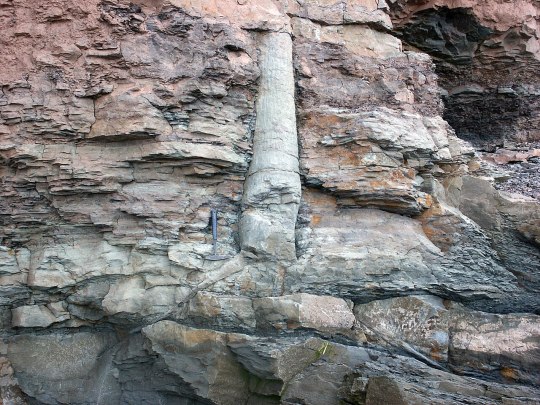
(Fossil Lepidodendron bark in the National Museum of Brazil, photo by Dornicke; a fossilised relative of Lepidodendron with some of its roots visible, photo by Michael C. Rygel)
So why would you ever try to photosynthesise with your roots of all things as a plant? Surely it would make much more sense to just transport the sugars created in other parts there than to have your roots be so shallow that bits of them can catch a little light and make it in situ? Sure, if you're capable of that! This is what modern trees do, but they have two separate vascular tissues they use for transport: xylem, which moves water from the roots to the rest of the plant, and phloem, which moves sugars and other photosynthetic products from the leaves to the rest of the plant. Unfortunately for Lepidodendron, it only had xylem, no phloem, so its sugars were only ever going to move as far as they could diffuse, so every part of the tree needed to have at least a little photosynthesis happening, even the roots.
This truly gets ridiculous when the Lepidodendron decides after a few years of charging up that it's time to reproduce. That's when the weird green stump we have so far starts shooting up, up, up, very quickly, all the way until an enormous 40 or 50 metres in height. Now, modern trees grow this large by being supported by a sturdy wooden core, but that's not what Lepidodendron did. To hold up the entire tree, it relies entirely on its outer bark thickening as it grows. In mechanical terms, it was little more than a huge hollow pole, probably creaking and swaying terribly in the wind. Although I have not been able to confirm this in the literature so far, I suspect that between the shallow roots and the whole thing being held up by its bark, you could probably total a Lepidodendron with a good kick.
Now remember, all this growth is happening without phloem, so the entire length of that stem has to not just be sturdy enough to keep the tree standing, but it also has to keep doing photosynthesis to feed itself. When it reaches its full height, the top of the tree finally starts sprouting branches and small leaves, leaving it looking like the picture at the start. But those are not what it's all about for the tree: the cones that develop among them are. At a height of 50 metres, the spores produced by the cones can very easily be picked up by the wind and blown far, far away. Being spores, rather than seeds as modern trees have, they have no supplies built in whatsoever, so they need to get lucky to land in a spot that has immediate access to water. Luckily, there are a lot of those in the vast Carboniferous swamps, and with the trees doing so much work to spread the spores very widely, some of them are sure to find good spots. And then, with the spores dispersed, the tree is done for. The entire thing, which has just grown to the skies, dies off and soon comes crashing down.
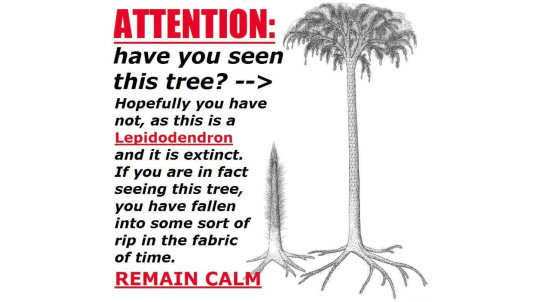
So how weird is this tree? I'd call it a perfect 10.
144 notes
·
View notes
Text
Round 2 - Mollusca - Scaphopoda


(Sources - 1, 2)
The class Scaphopoda is known more commonly for their shells, called “Tusk Shells” or “Tooth Shells.” They are the only class of molluscs to live exclusively below marine sediments. As such they are rarely seen alive, and even their shells are rarely found by beachcombers.
There are two orders of scaphopod: the Dentaliida (which may be paraphyletic) and the monophyletic Gadilida. Dentaliids are generally larger, have a shell which tapers uniformly, and their foot consists of one central and two lateral lobes which bends into the shell when retracted. They have strongly ribbed and rough shells. When they sense vibrations anywhere around them, their defensive response is to freeze, making them harder to sense by animals which can detect electrical signals. On the other hand, gadilids are much smaller, have a shell whose widest portion is slightly posterior to its aperture, and have a foot which is disk-like and fringed with tentacles which inverts into itself when retracted. Gadilid shells are usually glassy-smooth and narrow, allowing them to move with surprising speed through loose sediment to escape potential bottom-dwelling predators.
Scaphopod mantles are entirely hidden within their shell. Their foot extends from the larger end of the shell, and is used to burrow. Scaphopods position themselves head down in the substrate, with the tip of the shell projecting upward, but rarely above the level of the substrate. A number of minute tentacles around the foot, called captacula, sift through the sediment and latch onto bits of food, which they then pull into the mouth. The mouth has a grinding radula and cartilaginous oral bolsters that break the bits into smaller pieces for digestion. In gadilids these are structured like zippers where the teeth actively crush the prey by opening and closing on it repeatedly. In dentaliids these work like a ratchet to pull prey into the esophagus, sometimes whole. Their prey are primarily single-celled organisms called foraminiferans, though some will also supplement their diet with plant matter. Scaphopods have no gills; the entire surface of the mantle cavity absorbs oxygen from the water. They also have no eyes, no osphradia, any or other distinct sensory organs. However, scaphopods do possess genes involved in photoreceptor formation and function implying scaphopods may have had eyes that degenerated over evolutionary time. Scaphopods have separate sexes, and external fertilisation. Eggs will hatch into free-living trochophore larvae, which develop into veliger larvae that more closely resemble the adults. Their three-lobed foot originates prior to metamorphosis while the cephalic tentacles develop post metamorphosis.
There is a good fossil record of scaphopods, with them emerging in the Mississippian (Early Carboniferous). The Ordovician Rhytiodentalium kentuckyensis has been interpreted as an early relative of scaphopods.
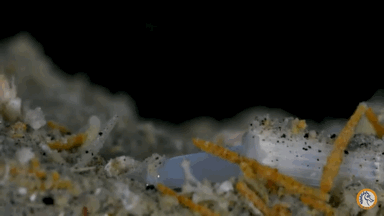
(source)
Propaganda under the cut:
Fissidentalium metivieri is the largest scaphopod, with a shell length of 18 cm (7.09 in).
While their phylogeny hasn’t been fully resolved yet, molecular data suggest that the scaphopods are a sister group to the cephalopods.
The shells of Dentalium hexagonum and Dentalium pretiosum were strung on thread and used by First Nations of the Pacific Northwest as currency. Dentalium shells were also used to make belts and headdresses by the Natufian culture of the Middle East, and are a possible indicator of early social stratification.
22 notes
·
View notes
Text
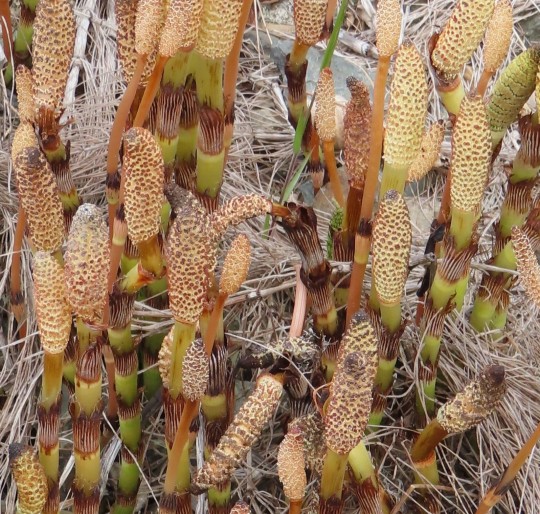
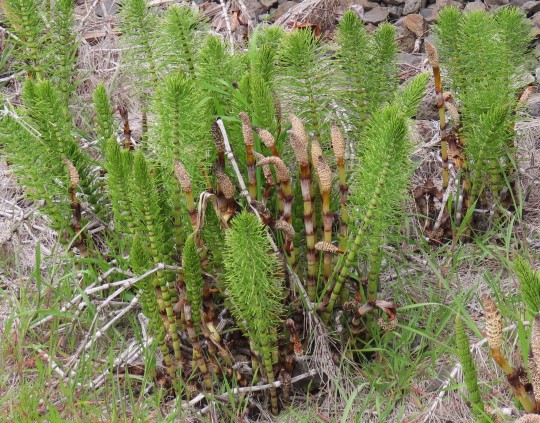
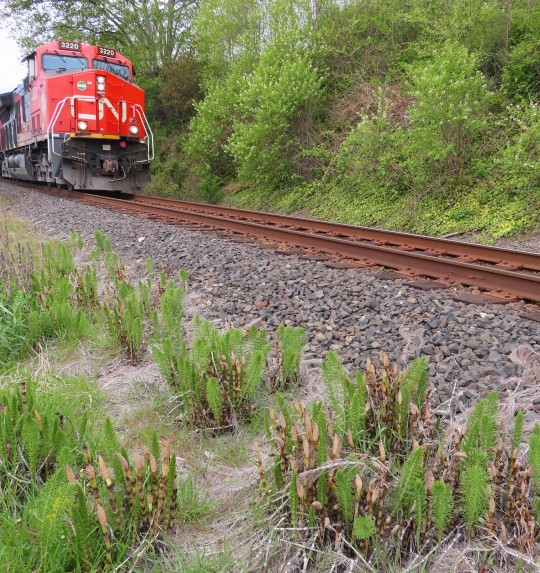

Equisetum telmateia subsp. braunii (giant horsetail)
Strange things are going on - on the other side of the tracks.
In the spring, horsetails produce these alien spore cones, technically called a strobilus. Horsetails are very ancient plants, the earliest ones go back to the Devonian, 380 million years ago. Land plants had just invented roots, leaves and seeds at this time and horsetails were right there at the beginning: Act 1, Scene 1. Equisetum telmateia has been accurately described as a 'living fossil'.
Horsetails have an interesting connection with the energy industry. In the Carboniferous period horsetails grew a hundred feet tall (30m) and those swamp forests produced over 90% of the world's coal deposits. As luck would have it, just as I was taking these photos, a CN freight train rumbled by with a hundred tanker cars of petroleum heading south. Of course oil is another type of fossil from Earth's ancient past. That's why they call it a fossil fuel.
#plants#photographers on tumblr#giant horsetail#native plants#spring plants#fleurs#flores#fiori#blumen#bloemen#Vancouver
63 notes
·
View notes
Note
💌
hey :3 lemme get to the ones I couldn't yesterday!
and you are one more of my extremely cool mutuals!! you've got that perfect combo of really technical interests and wry surreal gay jokes that I can't get enough of :p
but can I also say something about your name!! Anomalocaris canadensis is a really fucking cool animal. we looked at some weird spiral shapes in a bit of rock and applied our imaginations and build our computer simulations and write our comparative morphology papers and in the end we can say that there was very probably an animal that looked something quite like this:

and that 499 million years after the last of these animals died, some weird apes came along and did their best to reconstruct its form. by contrast I feel like the horizon for my last coherent effect on the world might be measured in the hundreds of years at the absolute outside. pretty good going, Anomalocaris!
and, this is a tangent of a tangent, but I love that palaeontology exists. It's one of the most purely 'knowledge for its own sake' sciences, like astronomy. In contrast to physics, biology, etc., which all lead to useful things that let us build bridges or nuclear missiles, cure diseases or engineer fatter chickens or exert other forms of power over the world for good or ill, it's very hard to achieve power from knowing about long dead animals and plants that used to live. Sure, fossil fuels - but you don't need to know much about Carboniferous rainforests to make use of the hydrocarbon sludge they turned into.
But palaeontologists are purely in it for the creatures (and plants and bacteria and all sorts of other beings), and the stories we can tell using what we know about those creatures about how we got here. In that sense, it's kind of an art form - but in contrast to fantasy artists making up creatures from culturally received images, this tradition involves a feedback loop between our imagination and the evidence we can gather from fossils, living animals, etc. etc. This model of Anomalocaris canadensis is pretty, but it's considered wrong, because we have been able to infer a bunch of extra stuff about the real animal, which Wikipedia editors helpfully summarise in this block of jargon:
Lacking head sclerites (evident in A. canadensis); Lacking neck flaps (3 pairs in Anomalocaris); stout frontal appendages with endites lacking auxiliary spines (frontal appendages laterally flatten with endites of intermediate podomeres possess auxiliary spines in A. canadensis).
And despite its lack of direct application to any form of engineering, humans have put the resources into palaeontology to get a really quite intricate knowledge of some fraction of the life that has existed on this planet. Look at this radial cladogram:

might as well be a solomonic pentagram for all the practical good it does, but it's beautiful. the cheeky little 'you are here'!
so from one really dorky academia URL to another, shoutout from canonical momentum to Anomalocaris canadensis :p
anyway returning to the 'saying nice things about mutuals' game, you ask lots of really interesting questions that I have a lot of fun engaging with! I had a great time with that chat about energy we had a little while back. so high fives across the wired ^_^
7 notes
·
View notes
Photo

Alethopteris Fossil Leaf Fern – Carboniferous Coal Measures – Radstock, Somerset, UK – Authentic Plant Fossil
Authentic Alethopteris Fossil Leaf Fern – Carboniferous Coal Measures – Radstock, Somerset, UK
This listing features a beautifully preserved fossilised leaf of Alethopteris, a type of seed fern (Pteridospermatophyta) common in Carboniferous coal swamps. This specimen was excavated from the historic Coal Measures strata in Radstock, Somerset, and dates to the Late Carboniferous Period (Pennsylvanian Subsystem), approximately 310 million years ago.
Geological & Palaeobotanical Details:
Fossil Genus: Alethopteris
Family: Alethopteridaceae
Order: Medullosales
Class: Pteridospermatophyta (Seed Ferns)
Geological Age: Carboniferous (Pennsylvanian)
Formation: British Upper Coal Measures
Depositional Environment: Moist, equatorial deltaic swamp with fluctuating water levels – a habitat ideal for dense vegetation and coal formation
Location: Radstock Coalfield, Somerset, United Kingdom
Morphological Features:
Distinctive bipinnate fronds with symmetrical leaflets (pinnae)
Prominent midribs and lateral venation typical of seed ferns
Leaves believed to belong to seed-bearing plants, now extinct
Biozone (if assigned): Typically associated with Lenisulcata or Gastrioceras ammonoid zones regionally
Fossil Identification: Described and classified in the 19th century; remains a key taxon in palaeobotany due to its prevalence and role in coal formation
Specimen Notes:
Discovered by: UKGE team members Alister and Alison
Discovery Date: 06 March 2025
Preparation: Cleaned, stabilised, and prepped by Alison
Condition: Well-defined fossil on natural matrix, showing clear detail of fossilised leaf structure
Photography: Scale cube = 1cm. Photos show actual specimen – what you see is what you will receive
Authenticity: Comes with Certificate of Authenticity – all fossils sold by us are genuine and responsibly sourced
Why Choose Alethopteris?
Alethopteris is not only a stunning example of Carboniferous flora but also a tangible link to the lush tropical landscapes that once dominated Europe. Its role in forming the vast coal beds of the UK makes it both a beautiful and historically significant specimen for collectors, educators, or as a natural history display.
Secure a genuine piece of Earth’s botanical past today with this expertly sourced and prepared fossil fern.
#Alethopteris fossil#fossil fern#Carboniferous plant fossil#Coal Measures#Radstock fossil#Somerset fossil#UK fossil plant#genuine fern fossil#Alethopterid leaf#palaeobotany#fossil foliage#Pennsylvanian fossil#authentic fossil leaf#seed fern fossil
0 notes
Text
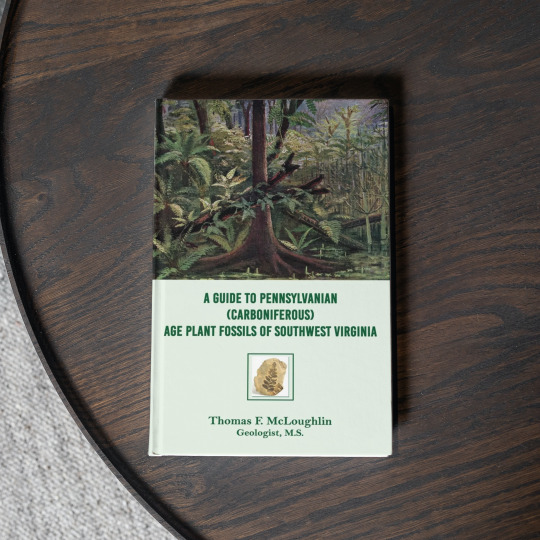
A Guide to Pennsylvanian (Carboniferous) Age Plant Fossils of Southwest Virginia by Thomas F. McLoughlin
Dive into the incredible fossil history of the Central Appalachians with "A Guide to Pennsylvanian (Carboniferous) Age Plant Fossils of Southwest Virginia" by Thomas F. McLoughlin, brought to life by over 300 vibrant images and clear explanations. This friendly guide brings fossils to life for everyone, from beginners to seasoned collectors.
Explore the ancient world beneath your feet. Grab a copy at www.tfmcloughlin.com.
#Thomas F. McLoughlin#A Guide to Penssylvanian Age#Plant Fossils#Carboniferous#Southwest Virginia#ReadersMagnet#fossils#ancient plants#paleontology#paleobotany#fossil plants#nature
0 notes
Text
Psst... Ya like trees?
Happy Carboniferous Week!
If the Earth's history were compressed into a single year, December 3rd - 7th marks the Carboniferous period (358.9-298.9 Mya).

This period is commonly broken up further in North America into the Mississippian and Pennsylvanian sub-periods (Tues.-Thurs. and Thurs.-Sat., respectively).
Because of the establishment of land plants in the Silurian and Devonian, the carbon cycle as we know it today was able to develop and really take off during this period, which resulted in an atmosphere which, for the first time, had modern oxygen concentrations. In fact, oxygen levels exceeded modern levels at times, and has been speculated in the past to be responsible for the large size of insects of the period. (Recent evidence suggests that more was behind their giant sizes than available oxygen, however).
How big of insects? How about dragonflies whose body is longer than your face, or millipedes over 6.5 feet long!? I am of course referring to Arthropleura and Meganeura


These big bugs wandered the earth at the same time as the first true tetrapods including the ancestors of birds and reptiles (the sauropsids) and the ancestors of modern mammals ( the synapsids). These early ancestors weren't all that recognizable to what we know today, and could take some unique forms. Like the synapsid Edaphosaurus:

The trees preserved from this time were also quite unlike many that grow today; they reproduced via spores, and some had extensive rhizomal root networks or bizarre tufted arrangements of needle-like leaves. Their only surviving descendants consist of species we'd describe as ground cover, such as horsetails and club mosses.
The name Carboniferous actually comes from a notable byproduct of the carbon cycle at the time: Coal. The grand majority of the Earth's coal deposits formed during this time in various swamps and marshy environments. Because of quick burial, and lack of anything that knew how to eat lignin, a lot of trees didn't rot and the carbon that trees took up were sequestered in the earth, rather than being released into the atmosphere. After heating and compression, this formed the black rock which fueled the industrial revolution. It is quite literally a fossil of this bygone age.
So to celebrate this week, hug a tree, marvel at horsetails, say hi to a dragonfly, and maybe look into how you can become involved in green initiatives near you.
10 notes
·
View notes
Text




The rocks in the Joggins Fossil Cliffs were formed during the Carboniferous Period, also known as the Age of Coal (coal contains the carbon from ancient plants, which gives this period its name). Huge, soggy swamps covered much of the land at the time, and primitive trees and ferns grew in thick, steamy forests.
#original photography#original photographers on tumblr#bay of fundy#Nova Scotia#Joggins Fossil Cliffs
17 notes
·
View notes
Note
Hi Norm,
I keep hearing about The Boiler. The Boiler hungers. Feed The Boiler. I was wondering what you FEED THE BOILER? When The Boiler is hungry.
Coal is a combustible black or brownish-black sedimentary rock, formed as rock strata called coal seams. Coal is mostly carbon with variable amounts of other elements, chiefly hydrogen, sulfur, oxygen, and nitrogen.[1] Coal is a type of fossil fuel, formed when dead plant matter decays into peat and is converted into coal by the heat and pressure of deep burial over millions of years.[2] Vast deposits of coal originate in former wetlands called coal forests that covered much of the Earth's tropical land areas during the late Carboniferous (Pennsylvanian) and Permian times.[3][4]
PRAISE BE THE PILOT LIGHT
Coal is used primarily as a fuel. While coal has been known and used for thousands of years, its usage was limited until the Industrial Revolution. With the invention of the steam engine, coal consumption increased.[citation needed] In 2020, coal supplied about a quarter of the world's primary energy and over a third of its electricity.[5] Some iron and steel-making and other industrial processes burn coal.
The extraction and use of coal causes premature death and illness.[6]
LIES AND SLANDER
#office for the preservation of normalcy#ask#The Boiler#CITATION NEEDED CITATION NEEDED CITATION NEEDED
16 notes
·
View notes
Text
Sailed Animals
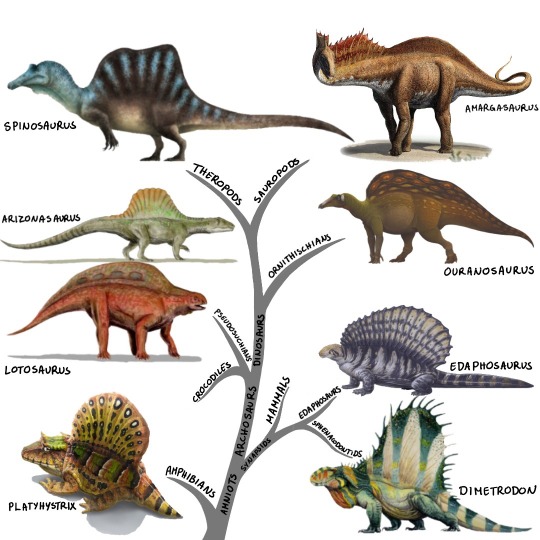
(Sailed animals and their relationships. Art by: Platyhystrix - Gabriel Uguento, Dimetrodon - Rob Soto, Edaphosaurus - Sean Closson, Arizonasaurus, Lotosaurus - Nobo Tamura, Spinosaurus - Liam Elward, Ouranosaurus - Scott Reid, Amargasaurus - Sergey Krasovskiy)
Okay, what I actually wanted to do, was write something about the Permian, and I will be doing that at some point - however, I got side tracked by Dimetrodon and Edaphosaurus and their sails, so here we are.
You see, I‘m a big fan of convergent evolution and especially when the evolution converges to some very specific and bizarre feature that we don‘t fully understand, like big sails on the backs of animals.
As you can see in the picture above, sails have evolved independently from each other many times. Some of the earliest instances come from the late Carboniferous and early Permian and include the amphibian Platyhystrix (I had no idea that there were sailed amphibians, that‘s so cool) and of course the famous carnivorous Dimetrodon and its plant-eating cousin Edaphosaurus. Edaphosaurus and Dimetrodon are often mistaken for reptiles or even dinosaurs. They were neither, but instead they were synapsids, the same group that includes us mammals.
The next time we see sails is during the Triassic in the crocodile-related Pseudosuchians, like the carnivorous Arizonasaurus or herbivorous Lotosaurus. I‘m not entirely sure, if the sails evolved only once in this group, or multiple times, because it is hard to find information on that (I really wish those croc-cousins would get the same attention as dinosaurs).
But speaking of dinosaurs: They of course also had sails. Most famous for it is Spinosaurus and its relatives, but other groups of dinosaurs also evolved sails. Those included the sauropods (the long-necked giant herbivores) like Amargasaurus (well, maybe?), as well as the Ornithopods (duck-billed dinosaurs and their relatives) like Ouranosaurus.
Now you might think that we have a clear lack of sailed animals at the moment, but don’t worry: there are still animals with sails! And somehow I was completely unaware of this until I started looking into it. We still have the Crested Chameleon, some species of basilisks, sail-fin dragons and the sailfish (although from what I understand its sail works differently then the ones of the lizards).

The sails of all these animals are made up from long extensions of the vertebrae. It is assumed that those bones were covered in tissue, spanning open a sail. We can be pretty certain of this, because there have been fossils found, where the bones had broken and then healed back together while the animal was still alive, clearly showing that they must have been held in place by something (Rega et al, 2012).
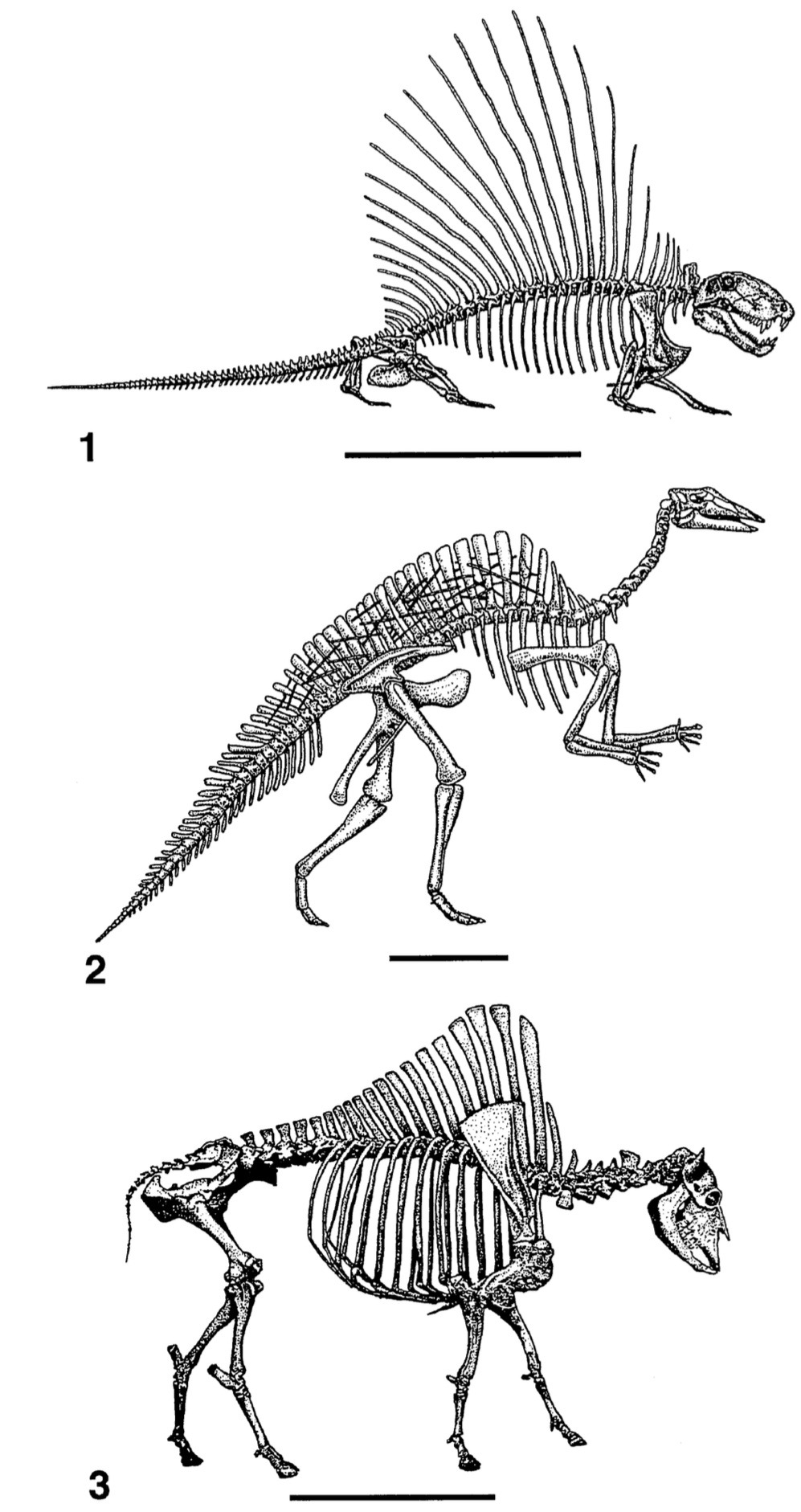
(skeletons of Dimetrodon, Ouranosaurus and a bison, Bailey 1997)
For different animals these bones can look very different though: For the synapsids like Dimetrodon they were very thin, while they were thicker and flatter in dinosaurs. In that way, they looked a lot more similar to the vertebrae of modern humped animals like bisons. This is why in the 90s there were some suggestions that those dinosaurs didn‘t have sails, but instead had big humps on their back for energy storage or maybe for insulation to keep a constant body temperature (Bailey, 1997).
The idea never really caught on, but we did this amazing illustration of a humped spinosaurus out of it. I know, we‘ve probably all seen our fair share of Spinosaurus reconstructions, but I have never seen a chonky one, and I don‘t know how to feel about it.
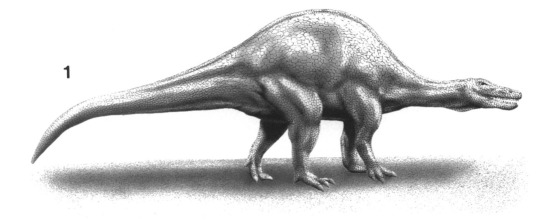
(humped Spinosaurus, Bailey 1997)
The big questions that remains is of course: why sails? what were they good for? The most common answer you get is either display or thermoregulation.
The sails being a display structure is a very intuitive answer. If you‘re carrying around a giant billboard-like structure on your back, it would only make sense to advertise something on it. You could use it to impress the opposite sex with fancy colors, intimidate rivals because it makes yourself look a lot bigger or signal to other animals that you are the same/a different species.
One thing that I always think about, but never see mentioned, especially in the case of the herbivorous sailed animals, is mimicry. Edaphosaurus and Dimetrodon lived at the same time, so could it not be, that Edaphosaurus had sails to make themselves look like big scary Dimetrodons to keep other predators away? Similar to how we have many harmless insects pretending to be wasps today? It would of course not explain why Dimetrodon had a sail, but it could give the herbivores a reason to have one.
The other big reason for sails is thermoregulation. Especially cold-blooded animals could have used their sails like solar panels, pointing them towards the sun and collecting heat (Bramwell & Fellgett, 1973). Alternatively, the sails could have been used to cool the animal down by positioning them in the direction of winds (Bennett, 1996).
The only problem with thermoregulation is, that its viability depends on whether the animals in question were endothermic or ectothermic (warm- or cold-blooded). And for pretty much all the sailed animals this is a heated (pun intended) debate.

(Airflow around an Edaphosaurus, Benett 1996; Can I just point out that this graph, as well as the chonky Spinosaurus were part of actual peer reviewed publications? I do chemistry irl and I‘m a bit jealous that in the papers I write I never get the chance to draw dorky looking synapsids)
Now that we‘ve discussed the reasonable well accepted explanations for sails, let‘s get into some more outlandish ones. Maybe Dimetrodon used its sail to „camouflage among reeds while [it] waited for prey, or as an actual boat-like sail to catch the wind while the animal was in the water“, as stated in multiple papers. I tried to hunt down the original source for this, but the idea comes from a Book by Romer and Price from 1940, and unfortunately I don‘t have access to it. Honestly, I would love to know if they had any actual reasoning for it or if they were just throwing ideas around, because the image of a Dimetrodon floating around on the surface of the water and getting pushed around by winds sounds ridiculous. Similarly, having a giant structure on your back, just so you can camouflage it to look like the background seems like a lot of unnecessary effort. Surely you could just not have the giant structure and it would have the same effect.
For Spinosaurus, there is the idea that they might have used their sails to shade the water while hunting, like a heron bird. I had never heard that before, but I find it a bit strange. Wouldn‘t that mean, that they had to catch fish at a weird angle towards their side? Seems uncomfortable. Of course there are also many ideas that the sails might have helped with swimming or whatever, but I don‘t want to get into the Is-Spinosaurus-aquatic-debate. I‘m pretty sure most of the papers about it would be outdated anyways and the ones that aren‘t will be in approximately 20 minutes.
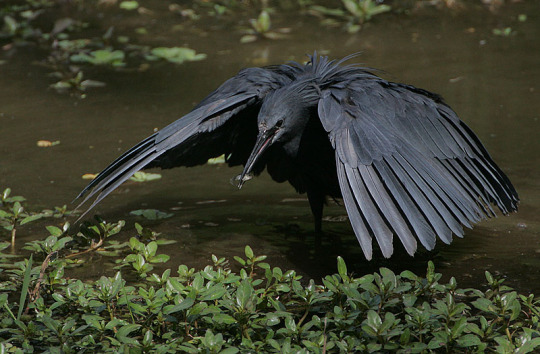
For the sauropods, the “long-necks“, like Amargasaurus, even less is clear: It is even debated whether the spines on their necks formed sails or horns. If they had horns those might have been a defense structure or just for display. If they had sails - well, then it‘s the same questions as for all the other weirdos.
So yeah, overall, sailed animals were pretty weird, and there is still a lot to learn.
Also “sail“ doesn‘t sound like a word anymore.
44 notes
·
View notes